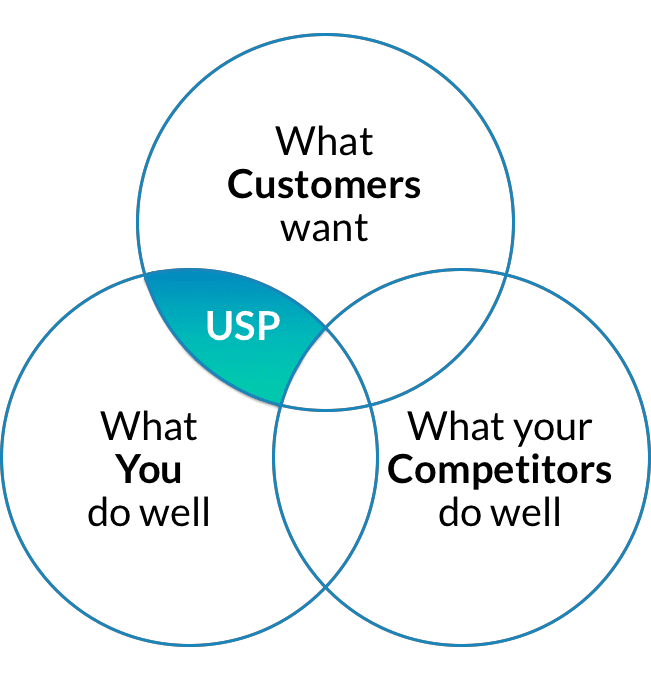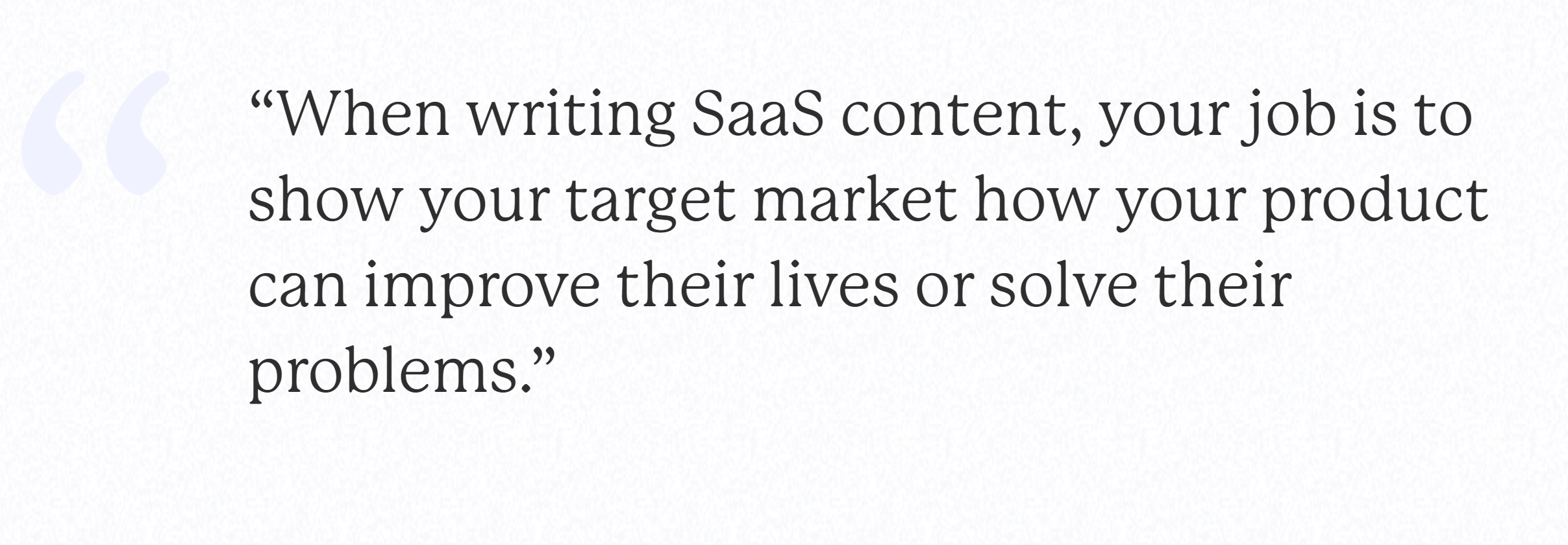A SaaS content company’s guide to SaaS copywriting
October 15, 2021
|
John Thomas
SaaS copywriting helps you market your digital products and convert customers. This guide covers our learnings as a SaaS content company.

What does SaaS mean?
Since its inception over 20 years ago, the term “Software as a Service” or “SaaS” has become commonplace in the tech vernacular. SaaS is a software distribution technique in which a third-party host offers consumers applications via the internet.
Customers can access and use the software, typically through a web browser, while the provider manages the infrastructure and security. SaaS has transformed how we use and purchase programs. In the past, if you wanted to use a particular application, you would have to buy it, install it on your computer, and keep it updated.
A monthly subscription now makes it possible to use the latest and greatest applications without making a large upfront investment.
Why is SaaS copywriting important?
You might be asking yourself “Can’t I just write what I think visitors should know, and call it a day?” Technically, yeah, you can. If you built the product, you might know all the ins and outs of it. But that can also become a problem when:
Your landing page word count gets too long because you’re going into too much detail about the product
You start focusing on features you’re proud of building, instead of focusing on benefits (or value propositions) visitors care about
You’re not getting the conversions you deserve
In that respect, SaaS copywriting helps you:
Drive more traffic
Get more mailing list signups
Increase your conversion rate
Lower your CPC and increase your click-through rates
Turn barely-aware visitors into people who are ready to solve their problems with your SaaS tool
What you think visitors should know and what they want to know are two wildly different things, and that’s why SaaS copywriting matters.
What does a SaaS copywriter do?
As with any product, SaaS companies need great copy to market and sell their wares. A SaaS copywriter is responsible for creating persuasive, engaging, and accurate text that describes the features and benefits of a company’s software offerings.
SaaS copywriting aims to generate leads and convert them into paying customers. To do this, SaaS copywriters must understand the needs of their target audience and craft messages that speak to those needs. They must also be able to clearly communicate the unique value proposition of their company’s products. In some cases, SaaS writers are also responsible for describing how the product actually works via support guides.
SaaS copywriting is a specialized form of copywriting that requires a deep understanding of both the SaaS industry and the art of persuasion. They play on emotions and tap into the unique desires of their target audience to get them to take action.
Learn more about content roles and responsibilities in the Draft Resource Center.
Generally speaking, a SaaS copywriter will be responsible for:
SaaS product descriptions
Software is the product here, and SaaS companies need excellent copy to describe and sell it. A SaaS copywriter will write compelling product descriptions that highlight the features and benefits of a company’s software offerings. They might include screenshots, customer testimonials, or infographics to further illustrate the product’s value.
SaaS landing pages
A SaaS company’s website is among its most important marketing assets. It’s where potential customers go to learn more about a company and their offering, usually arriving from an online search or paid advertising. A SaaS copywriter will write persuasive, keyword-rich landing page copy that compels visitors to take an important action, such as signing up for a free trial or requesting a demo.
SaaS emails
Email is a key part of any SaaS company’s marketing mix. A SaaS copywriter will create influential landing pages that drive conversions by clearly communicating the benefits of a company’s products. A good tech copywriter can also write drip campaigns, welcome emails, and other types of email content.
Documentation and knowledge base copywriting
Wait, but isn’t a knowledge base just a… knowledge base?
We hear ya, but your knowledge base and your documentation is so much more than that. It’s proof that your tool will be simple to use, your features powerful enough to help your customers achieve their goals, and more.
So as you contemplate landing page and blog copywriting, make sure you pay attention to your knowledge base, as well. Think of it as your personal how-to blog posts.
Learn about other content types that a SaaS copywriter can create or get additional tips for SaaS copywriting per content type.
SaaS copywriting strategies
So how do you write excellent copy for a SaaS product? Here are some tips and strategies:
Define your value propositions

Source: Tractionwise
Every SaaS company has unique value propositions or unique selling points (USPs). These are the reasons why someone should buy your specific product, and they’re based on the features and benefits that make your offering superior to others in the market. This might be a specific feature of your product, a methodology behind your service that makes it unique, or even just the level of customer service you offer.
Before you start writing, take some time to define your company’s value props clearly. What makes your company, product, and service better than the competition? Why should someone buy it? Once you have a solid understanding of your value props, you can start crafting messages that highlight them.
For example, a SaaS company that offers cloud-based accounting software might have the following value props:
Save time on data entry with automatic bank and credit card import
Get a real-time view of your financial health with customizable dashboards
Reduce expenses with automated invoicing and payments
Notice how each value prop is specific and quantifiable. This is important because it helps to set your product apart from the competition and makes it easy for potential customers to understand the benefits of using your software.
Include data
Numbers don’t lie. When writing copy for a SaaS product, be sure to include data that supports your claims. If your product has helped customers save time or money, include those stats in your copy. You might also consider sharing more general data about your company, such as how many customers you have or how long you’ve been in business.
We often see claims like: “Trusted by over 1,000 businesses” or “Used by millions of people around the world.” These statements help to build trust and credibility, two important factors in any SaaS sale.
Many SaaS copywriters also include social proof as a form of anecdotal data, such as customer testimonials, in their copy. This can effectively show potential customers that your product is trusted and used by real people.
Lastly, it helps to conduct official studies and gather statistics that you can use in your copy. These stats are well-represented in infographics, which can be reused in blog posts, social media, and other marketing materials. For example, “a study conducted by Gartner found that using SaaS applications can help businesses save 20-30% on software costs.”
Speak the audience’s language
Ideally, you’ve already created customer personas for your target market. These personas help you understand your audience deeper, including their needs, wants, and pain points. When writing copy for a SaaS product, be sure to speak the language of your target audience.
Use the same terminology to describe their problems and explain how your product can help them overcome those hurdles.
It can also be helpful to address common objections that your target market might have about your product. For example, if you’re selling a SaaS product that requires a monthly subscription, you might want to address the common objection that “SaaS is too expensive.” You could do this by explaining the value of your product in terms of how much it would cost to purchase the same software outright.
Social listening tools can be a great way to stay up-to-date on the latest trends in your industry and learn how people are talking about your product. This information can be used to improve your copy and make sure it’s relevant to what your audience is interested in.
Likewise, user testing can be valuable to get feedback on your copy and your product from real people in your target market. Simply put, user testing is the process of having someone use your product (sometimes for free) and provide feedback on their experience. This feedback can be used to improve your product as well as your marketing copy and make sure it’s clear, concise, and easy to understand.
Avoid jargon and technical terms
It’s no secret that SaaS products can be complex, and sometimes that complexity is unavoidable. However, when writing copy for a SaaS product, it’s important to avoid jargon and technical terms whenever possible.
Your goal should be to write in a way that is easy to understand, even for someone unfamiliar with your product’s ins and outs. The buyer might not use it daily, so it’s important to ensure your copy is accessible to as many readers as possible.
One way to avoid jargon is to use plain language in your copy. That means using short, simple sentences and avoiding words that might be unfamiliar to your audience. Another way to prevent confusion is to define any unavoidable technical terms you use. It can be done in a separate glossary or simply by adding a brief definition after the word is first used. Glossaries and term definitions are a great way to build up SEO value over time too.
It’s also important to avoid using industry-specific acronyms in your copy or to at least explain them where they’re essential. Not everyone reading your document will be familiar with these acronyms, so they could get lost (and frustrated) trying to figure out what they mean.
One sanity check for SaaS copy is to have a friend or colleague from another industry or department review the copy. If they’re able to understand the concepts, it may be an indication that you’ve simplified the copy well.
“When writing SaaS content, your job is to show your target market how your product can improve their lives or solve their problems.”
Drive emotional responses
As mentioned above, a considerable aspect of copywriting is tugging at the heartstrings of your target market. SaaS products can be expensive, and people don’t like parting with their hard-earned money unless they’re sure they’re getting value for it. And one of the greatest values to your audience will be emotional value.
If you write marketing copy for a banking software, for example, you might be tempted to simply explain that the platform saves your clients money on banking fees. However, taking that a degree further and highlighting that the platform helps you save for your audience’s financial goals like buying a home or saving for children’s college tuition is more compelling because of the emotional ties.
When writing SaaS content, your job is to show your target market how your product can improve their lives or solve their problems. Using emotionally-charged language and examples in your copy can help to drive this point home.
Integrating real-life stories or examples into your copy can also be a great way to connect with your target market on an emotional level. When people see how your product has helped others, they’ll be more likely to relate to those stories and see how your product could help them as well.
In addition to writing emotionally-charged copy, it’s also important to pay attention to the overall tone of your writing. The tone of your copy should be positive and upbeat, without being too salesy or pushy.
Anticipate objections
Human brains are weird, you guys. We could be looking straight at something that can help us and yet, our weird little neurons would be looking for reasons not to go proceed with the purchase.
This is where good SaaS landing page copywriting jumps in: it addresses objections, and gives visitors all the reasons they need to convert.
Sometimes, a FAQ section will do. Other times, you have to subtly overcome objections.
For example, if you have a B2B product, you need to understand that your visitors will be thinking about their manager’s approval. So give them ways to convince their manager (budget optimization, better reporting, etc.).

Source: Moz Whiteboard Fridays on landing page objections
Strategize concise CTAs
At the end of most content, there’s a call to action (CTA) that tells the reader what to do next. For SaaS products, the goal of the CTA is usually to get the reader to sign up for a free trial or demo of the product. It might also entice them to download a white paper or e-book about the product.
When writing CTAs for a SaaS product, it’s important to be clear and concise. Your CTA should be easy to understand and leave no room for interpretation. For example, a good CTA might say, “Sign up for a free trial” or “See how our product can help you.” Effective CTA copy indicates where the link will take users, and the page that follows should make good on the promise in the CTA itself.
It’s also crucial to ensure your CTA is visible and stands out from the rest of the copy. Use a different color or font size for your CTA so that it’s easy for the reader to see. You might also want to put your CTA “above the fold” on your page, meaning it’s visible toward the top of the page so a reader doesn’t have to scroll down to see it.
Test it out
Last but not least, testing your SaaS copy before launching your product is essential. Even if you think your copy is perfect, there’s always a chance that something could be improved. The best way to find out is to test different versions of your text with a small group of users or via an A/B testing tool to see what responses it earns.
You can submit your copy to friends, colleagues, or even strangers for feedback. Take a look at the comments and see if there are any recurring themes. If readers are confused about a specific part of your copy, revise it to make it clearer.
You can also use A/B testing to test different versions of your copy. This strategy involves showing two different versions of your copy to two groups of people and seeing which version performs better. A/B testing can be a great way to fine-tune your SaaS copy and ensure that it’s as useful as possible.
Hire a SaaS copywriter
Due to the impact SaaS copywriting can have on any business, many opt to hire freelance or full-time professional copywriters specializing in this area. Outsourcing this task to an expert can help to ensure that your SaaS copy is top-notch and effective, and give you back time to focus on other aspects of your business.
Hiring writers through a platform like Draft can help you create SaaS copy that’s designed to convert. Some benefits of entrusting your SaaS copy to a professional include:
More time to focus on other aspects of your business: When you hire a copywriter, you can free up some time in your schedule to focus on other tasks. This is especially beneficial if you’re running a one-person operation or have a lot on your plate.
Get an outside perspective: It can be challenging to be objective about your own business. A professional copywriter can provide an outside perspective and help you to see your business in a new light. This can be invaluable when it comes to crafting compelling SaaS copy.
Benefit from years of experience: Professional copywriters have years of experience crafting copy for a variety of brands and clients. This means that they’ve seen what works and what doesn’t.
Learn more about Draft’s writer marketplace to get started.
The bottom line
SaaS copywriting is a unique and important skill. When bringing a SaaS product to market, it is downright vital. Keep the tips in this article in mind as you work on your SaaS copy, and consider hiring a professional copywriter to help you create a compelling and persuasive copy.



